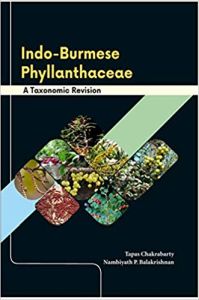
Contents: Preface. Introduction. Taxonomy. Subfamily I. Antidesmatoideae: Tribe I. Antidesmateae: Subtribe 1a. Antidesmatinae. 1. Antidesma. Subtribe 1b. Hymenocardiinae. 2. Hymenocardia. Tribe 2. Bischofieae. 3. Bischofia. Tribe 3. Scepea. 4. Aporosa. 5. Baccaurea. Subfamily II. Phyllanthoideae. Tribe 4. Bridelieae. Subtribe 4a. Bridelineae. 6. Bridelia. Subtribe 4b. Pseudolachnostylidinae. 7. Cleistanthus. Tribe 5. Phyllantheae. 8. Breynia. 9. Flueggia. 10. Glochidion. 11. Margaritaria. 12. Phyllanthus. Tribe 6. Poranthereae. 13. Actephila. 14. Andrachne. 15. Leptopus. 16. Meineckia. Bibliography. Index. Botanical names. Vernacular names.
The family Phyllanthaceae is a segregate of the heterogeneous mega-family Euphorbiaceae, based on phylogenetic considerations, placed in the order Malpighiales under Eudicotidae, a clade in flowering plants. The family is distinct in their pollen grains showing three colpi or grooves paralleling the polar axis and biovulatelocules of ovaries. They also show bitegmic ovules with non-vascularized inner integument and exarillate seeds.
The family is cosmopolitan mainly distributed in humid tropics. The authors have revised the family as represented in India, Pakistan, Nepal, Bhutan, Bangladesh, Burma (Myanmar) and Sri Lanka forming a distinct phytogeographical conglomeration. This work includes 2 subfamilies, 6 tribes, 16 genera and 214 species. The biggest genus is Phyllanthus with 67 species, which includes the medicinally important Amla, the Indian gooseberry (Phyllanthusemblica). There are several economically and medicinally important species in the family.
The work provides detailed descriptions of the family, subfamilies, tribes, genera and species. For easy identification bracketed keys to all levels of classification are provided. For each species, detailed nomenclature, typification, description, flowering and fruiting period, local names, habitat, distribution and specimens examined have been provided. Photographs of 93 species have been included for quick identification. A comprehensive bibliography includes citations of important literature relevant to the area.